On-Demand Outsourcing BPO Services for Healthcare Providers With 24/7 Coverage!
Save up to 70% on staffing costs!
Browse Specialty Staffing ServicesOptimizing Healthcare Operations: Tips for Reducing Wait Times

Long wait times remain one of the biggest challenges in healthcare today. Patients become frustrated when faced with delays in receiving medical attention, while providers struggle to manage capacity and meet growing demand. These inefficiencies can lead to poor patient experiences, staff burnout, and workflow disruptions that impact the quality of care. Implementing strategies for reducing wait times in healthcare is essential to streamlining operations, improving patient satisfaction, and ensuring providers can deliver timely, high-quality care.
Fortunately, there are practical solutions for reducing wait times in healthcare and improving overall efficiency. Tools like virtual medical assistants, healthcare BPO, and provider credentialing help streamline administrative processes, allowing providers to focus more on patient care. By implementing these strategies, healthcare facilities can minimize scheduling conflicts, speed up insurance verification, and enhance the patient experience—leading to a more efficient and patient-centered healthcare system.
Understanding the Causes of Long Wait Times
The Role of Variability in Patient Demand
Why do some days feel like a chaotic whirlwind, while others pass with empty waiting rooms? The variability in patient demand is a major contributing factor to long wait times. From seasonal fluctuations to unexpected spikes in acute cases, this unpredictability creates bottlenecks. Addressing variability starts with understanding patterns. Data insights about peak demand times can help healthcare facilities adapt and allocate resources more appropriately.

Administrative Challenges and Bottlenecks
Administrative inefficiencies can add significant delays to healthcare delivery. Issues such as prior authorization and insurance verification often slow down patient schedules. Additionally, a sluggish provider credentialing process hinders physicians’ ability to start seeing patients promptly. By identifying and resolving these administrative bottlenecks, healthcare providers can significantly reduce wait times and improve patient flow.
Actionable Strategies to Optimize Healthcare Operations
Let’s shift focus to solutions providers can adopt to streamline operations and address wait time issues.
Streamline Scheduling with Virtual Medical Assistants
Virtual medical assistants are game-changers for managing patient appointments seamlessly. Imagine having an assistant that never tires, ensures no slot is wasted, and maximizes your scheduling efficiency. A virtual assistant can handle appointment bookings, confirmations, and follow-ups, freeing up your on-site staff for patient care. Interested in learning how this works? Check out this insightful guide on virtual medical assistants.
Enhancing Administrative Processes with Healthcare Outsourcing
Healthcare outsourcing or BPO can tackle time-consuming tasks that often burden your team. From billing to claim submissions, outsourcing helps streamline workflows and allows staff to focus on essential medical care. By leveraging outsourcing, providers can decrease delays caused by prior authorization and insurance verification processes. Dive deeper into the benefits of healthcare BPO and how it can revamp your practice.
Efficient Use of Surge and Base Capacities
Instead of expanding resources prematurely, many facilities can optimize existing assets. Using overtime sparingly allows facilities to handle demand surges without overloading regular schedules. Base capacity should also be managed carefully to ensure a balance between cost-effectiveness and flexibility. Start by analyzing current capacity usage and identifying inefficiencies before investing in costly expansions.
Integrating Technology for Better Patient Flow
Technology is transforming healthcare operations, making it easier than ever to manage patient flow and reduce wait times. Here are two tech-driven solutions making a significant impact:
Leveraging Telemedicine and Remote Solutions
Telemedicine is revolutionizing healthcare access. By reducing the need for in-person visits, it lowers the burden on physical facilities, freeing up resources for urgent cases. Patients can get medical advice, prescriptions, or follow-ups from the comfort of their homes. This not only improves access but also eliminates unnecessary delays. Learn more about how telemedicine benefits emergency department operations.
RCM Tools and Data Analytics
Revenue cycle management (RCM) tools do more than just track finances—they help refine patient flow. These tools identify patterns in billing, insurance verification, and overall operational efficiency. With data analytics, providers can anticipate demand, allocate resources better, and create efficient schedules. Discover the essentials of RCM and its role in healthcare.
The Benefits of Provider Credentialing and Insurance Verification
Administrative tasks like provider credentialing and insurance verification often go unnoticed until they cause major delays. A smooth onboarding process for both patients and providers is essential for efficient healthcare delivery.
Reducing Errors in Prior Authorization and Insurance Verification
Mistakes in prior authorization and insurance verification can lead to treatment delays or even financial losses. Adopting automated tools and setting clear validation processes minimizes human error. Simple steps like verifying coverage early and using consistent workflows can go a long way in reducing disruptions. For a comprehensive look at best practices, explore how insurance verification impacts revenue cycles.
Conclusion
Reducing wait times isn’t just about managing schedules; rather, it’s about rethinking how healthcare operations are structured. By utilizing virtual medical assistants and improving patient flow with telemedicine, providers can ease the burden on staff while also shortening wait times for patients. Furthermore, healthcare BPO services and efficient provider credentialing processes offer even more opportunities to streamline operations and enhance overall efficiency. Moreover, by adopting these strategies, healthcare providers can transform inefficiencies into opportunities for patient-centered care.
What Did We Learn?
Long wait times are a major challenge in healthcare, frustrating patients and straining providers. Reducing wait times in healthcare requires a combination of strategies, including virtual medical assistants, healthcare outsourcing, and provider credentialing. By streamlining scheduling, optimizing administrative workflows, and leveraging technology like telemedicine and RCM tools, healthcare providers can improve patient flow and operational efficiency. Implementing these solutions not only reduces delays but also enhances patient satisfaction and overall care quality.
What People Are Asking?
1. Why is reducing wait times in healthcare important?
Long wait times negatively impact patient satisfaction, delay treatments, and increase provider workload. Reducing them improves efficiency and patient care.
2. How do virtual medical assistants help with wait times?
Virtual medical assistants manage scheduling, confirmations, and follow-ups, ensuring appointments run smoothly and minimizing no-shows.
3. What role does healthcare outsourcing (BPO) play in reducing wait times?
Outsourcing administrative tasks like billing, prior authorization, and insurance verification helps reduce processing delays and allows staff to focus on patient care.
4. How can telemedicine help reduce wait times?
Telemedicine enables remote consultations, reducing the need for in-person visits and freeing up physical resources for urgent cases.
5. What impact does provider credentialing have on wait times?
Efficient provider credentialing ensures doctors can start seeing patients without unnecessary delays, improving overall healthcare access.
Disclaimer
For informational purposes only; not applicable to specific situations.
For tailored support and professional services,
please contact Staffingly, Inc. at (800) 489-5877
Email : support@staffingly.com.
About This Blog : This Blog is brought to you by Staffingly, Inc., a trusted name in healthcare outsourcing. The team of skilled healthcare specialists and content creators is dedicated to improving the quality and efficiency of healthcare services. The team passionate about sharing knowledge through insightful articles, blogs, and other educational resources.
 Book a Demo to Build Your Team Today!
Book a Demo to Build Your Team Today!
 Read Case Studies
Read Case Studies 



 Virtual Medical Assistants
Virtual Medical Assistants



